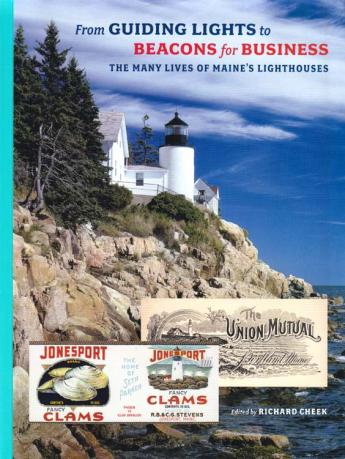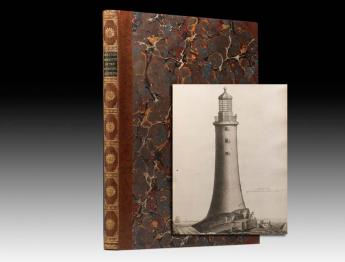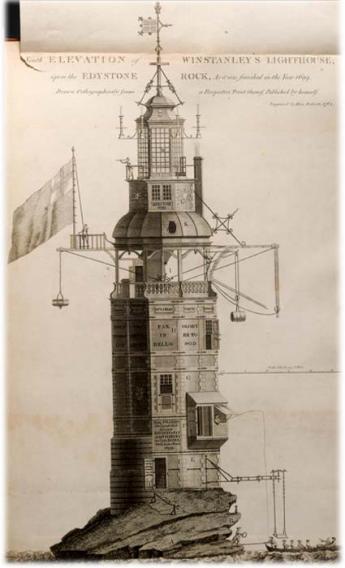Antiquarian Booksellers' Association of America Ten Pound Island Book Company
Collecting Rare Books and First Editions - Guiding Lights

By Greg Gibson
I’ve ranted before about lighthouses being one of those subject areas from which collectors have mysteriously vanished. People scrabbling and clawing in the most fearsome way for lighthouse literature and then one day, more or less out of the blue, they don’t want any at all. Not even the rarest material. I suspect that in this case, eBay and print-on-demand technology killed the market. The field was largely information driven, and once people got access to cheap reprints or bargain copies of scarce texts, the game was over for dealers like me.
This is not to say that the public lost interest in lighthouses. These structures retain their potency as images, symbols, and historical monuments. They still account for innumerable postcards, tourist pamphlets and glossy coffee table books.
Despite the disappearance of my lighthouse customers, I keep having lighthouse conversations at book fairs with a fellow named Richard Cheek. He is a professional photographer and he’s been engaged, as a sort of a sideline, in a hunt for images showing the many ways in which lighthouses are represented in our culture. He never bought much – I never brought much – but we’ve had several interesting talks about the symbology of lighthouses.
I gathered he was writing a book. But if I had a nickel for everyone who told me they were writing a book…
Then one day this fall the book actually appeared. And by golly, it’s a corker.
It’s called From Guiding Lights to Beacons for Business: The Many Lives of Maine’s Lighthouses. Predictably, it’s a history and survey of the lighthouses that dot the Maine coast. Some of my favorite Maine historians – Bill Bunting and Earle Shettleworth among them – contribute essays. And, just as predictably the whole package is larded with delicious images of proud towers and craggy coastline.
But the book is noteworthy for quite another reason.
One of the things I’ve always liked about Richard is that he’s a knowledgeable collector of ephemera. As editor of Guiding Lights he has deployed his knowledge of the field in a most remarkable way.
The narrative history is woven in with, and supported by, an arresting assemblage of images from popular illustrations - sheet music, advertising posters, magazine covers, postcards, religious tracts, railroad and steamship guides, snapshots, occupational, vernacular and historical photographs, lobby cards, and labels from products as diverse as cranberry sauce and whiskey.
Not only do the images delight the eye and speed the reading, they provide context in an immediate, powerful way, for the historical essays. So, for example, Bunting’s essay on the hazards of coastal navigation is illustrated with, among other things, wood engravings from Harper’s Magazine, a Currier and Ives print, and a chromolithograph of a piece of sheet music titled “The Hurricane.” As Bunting narrates, we see, from contemporary book illustrations, how a person of Longfellow’s day might envision The Wreck of the Hesperus.
In effect, the ephemeral images create a parallel narrative to essays on the architecture, dangers, moral significance, and commercial uses of Maine’s lighthouses. I wonder if, as this visual epoch progresses, we’ll see greater use of ephemeral imagery to supplement historical narrative. Hope so. It really works!
The book, all 240 pages of it, with doublefold color covers, is published by Historic New England. If there’s a maritime historian, a lighthouse freak, or a fan of all things Down East on your Christmas list, you can order the book by clicking here.
**********
There is one lighthouse book that survived the crash of the lighthouse market. It endured as a desirable title simply because it is the most magnificent lighthouse book in existence. A monument. A guiding light to book collectors of all stripes. Back in the day, it was the be-all and end-all of lighthouse books. It still is.
Smeaton, John. NARRATIVE OF THE BUILDING AND A DESCRIPTION OF THE CONSTRUCTION OF THE EDYSTONE LIGHTHOUSE ...
Lon. 1791. b/w engravings. Elephant folio. xiv, 198 pp. plus title engraving and 23 plates. The first Eddystone lighthouse was built in 1698 by Henry Winstanley on a dangerous reef at the western end of the English Channel. He then built an improved version a few years later.
Though it was an aid to navigation, Winstanley’s structure was limited by the technology available to him at the time. Anchored to the rock with iron bars, it was washed away during a great storm in 1703. Because of the danger presented by the Eddystone Rocks, a third structure was built in 1708 by John Rudyerd. This one was better anchored but, being built of wood, it burned in 1755.
Then, between 1755 and 1759 civil engineer John Smeaton built his iconic lighthouse on the Eddystone Rocks. Owing to its innovative construction, it fared much better than earlier attempts. It was built of interlocking granite blocks and, for its foundation, used a mixture of clay, quicklime, sand, and slag. Known at the time as “hydraulic lime” this material had the virtue of being able to set up and harden under water – obviously a desirable property in construction of a lighthouse. It was the first use of concrete in the modern era. The new Eddystone lighthouse was an engineering marvel in its day, and it stood until 1877 - testimony to the genius of its builder.
In 1791, at the end of a long career, Smeaton published “Narrative of the Building and a Description of the Construction of the Edystone Lighthouse,” which is a history of earlier attempts, and a detailed explanation of the construction methods he used. In its own way, and certainly by Smeaton’s design, his book is as monumental as his lighthouse. It stands nearly two feet tall and is illustrated with dramatic folio engravings and maps. This is a fine copy, bound in period-style three quarter brown calf, gilt-decorated spine, black morocco spine label, and marbled boards.
(Posted on Bookman’s Log, presented here by permission of the author.)


